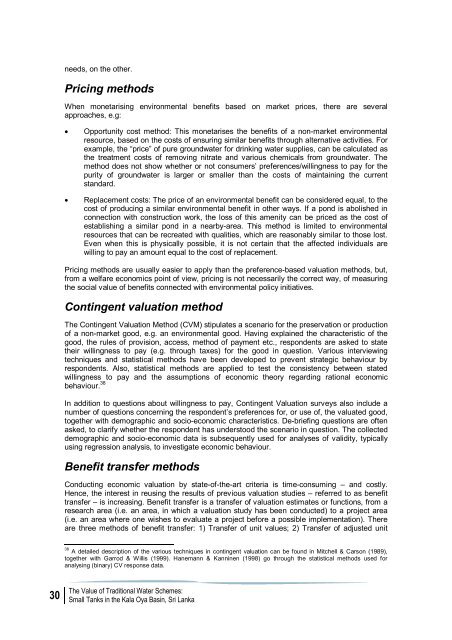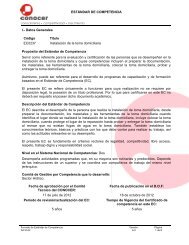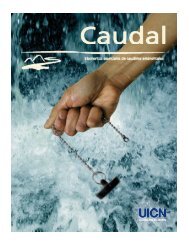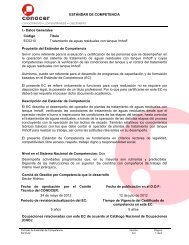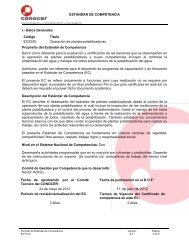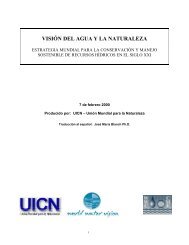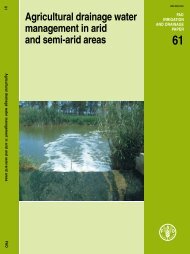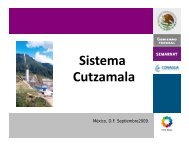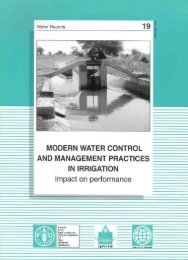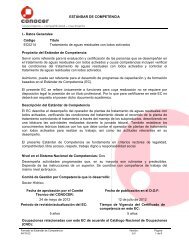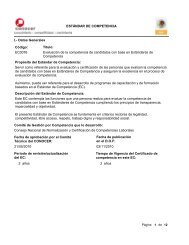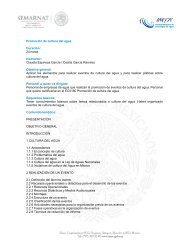needs, on the other.Pricing methodsWhen monetarising environmental benefits based on market prices, there are severalapproaches, e.g:• Opportunity cost method: This monetarises the benefits of a non-market environmentalresource, based on the costs of ensuring similar benefits through alternative activities. Forexample, the “price” of pure groundwater for drinking water supplies, can be calculated asthe treatment costs of removing nitrate and various chemicals from groundwater. Themethod does not show whether or not consumers’ preferences/willingness to pay for thepurity of groundwater is larger or smaller than the costs of maintaining the currentstandard.• Replacement costs: The price of an environmental benefit can be considered equal, to thecost of producing a similar environmental benefit in other ways. If a pond is abolished inconnection with construction work, the loss of this amenity can be priced as the cost ofestablishing a similar pond in a nearby-area. This method is limited to environmentalresources that can be recreated with qualities, which are reasonably similar to those lost.Even when this is physically possible, it is not certain that the affected individuals arewilling to pay an amount equal to the cost of replacement.Pricing methods are usually easier to apply than the preference-based valuation methods, but,from a welfare economics point of view, pricing is not necessarily the correct way, of measuringthe social value of benefits connected with environmental policy initiatives.Contingent valuation methodThe Contingent Valuation Method (CVM) stipulates a scenario for the preservation or productionof a non-market good, e.g. an environmental good. Having explained the characteristic of thegood, the rules of provision, access, method of payment etc., respondents are asked to statetheir willingness to pay (e.g. through taxes) for the good in question. Various interviewingtechniques and statistical methods have been developed to prevent strategic behaviour byrespondents. Also, statistical methods are applied to test the consistency between statedwillingness to pay and the assumptions of economic theory regarding rational economicbehaviour. 38In addition to questions about willingness to pay, Contingent Valuation surveys also include anumber of questions concerning the respondent’s preferences for, or use of, the valuated good,together with demographic and socio-economic characteristics. De-briefing questions are oftenasked, to clarify whether the respondent has understood the scenario in question. The collecteddemographic and socio-economic data is subsequently used for analyses of validity, typicallyusing regression analysis, to investigate economic behaviour.Benefit transfer methodsConducting economic valuation by state-of-the-art criteria is time-consuming – and costly.Hence, the interest in reusing the results of previous valuation studies – referred to as benefittransfer – is increasing. Benefit transfer is a transfer of valuation estimates or functions, from aresearch area (i.e. an area, in which a valuation study has been conducted) to a project area(i.e. an area where one wishes to evaluate a project before a possible implementation). Thereare three methods of benefit transfer: 1) Transfer of unit values; 2) Transfer of adjusted unit38A detailed description of the various techniques in contingent valuation can be found in Mitchell & Carson (1989),together with Garrod & Willis (1999). Hanemann & Kanninen (1998) go through the statistical methods used foranalysing (binary) CV response data.30The Value of Traditional Water Schemes:Small Tanks in the Kala Oya Basin, Sri Lanka
values and 3) Transfer of the entire valuation function from the original study (see e.g. Garrod &Willis, 1999). The simplest procedure is transfer of unit values, e.g. the estimated willingness topay per ha of a re-established nature area. It will often be necessary to adjust the unit values,e.g. by considering differences in income between the research area and the project area. Froma methodical point of view, the best procedure would be to transfer the entire estimatedvaluation function from the original study – with the various explanatory variables, regardingsocio-economic and geographic characteristics etc. However, data limitations often set narrowlimits on the extent to which the original estimates can be calibrated.Considering the limited possibilities of correcting the numbers, selecting the proper valuationstudies becomes the essential criterion, regarding the reliability of the transferred benefitestimates. Desvousges et al. (1992) identify five criteria for selecting valuation studies for thepurpose of transferring benefit estimates:• The employed valuation studies must fulfill state-of-the-art criteria for economic valuation• The studies must thus contain regression results, describing the willingness to pay, as afunction of socio-economic characteristics etc.• The research area and the project area must, to the greatest extent possible, containcoinciding characteristics regarding the natural setting, as well as the pattern of utilization• Consumers´ substitution possibilities between various environmental benefits in theresearch area, must be similar to the substitution possibilities found in the project area.Experiments with the methods of benefit transfer show, that there is a considerable uncertaintyconnected with this sort of benefit evaluating (Garrod & Willis, 1999). Yet, benefit transfer isrecommended as an acceptable procedure by e.g. American and British environmentalagencies (see U.S. EPA, 2000 and U.K. Treasury, 2000). All things considered, it seems thatone can get a fair impression of the orders of magnitude for various environmental benefitsthrough benefit transfer. As far as possible, however, actual policy-analysis should be based ondata collected through primary research.Study methodologyParticipatory techniques were used as the principal methodology, for collecting informationabout the multiple uses of the selected wetlands. Most of the tank users live in the vicinity of thetank, and they earn their living mainly from agriculture, livestock, and the resources extractedfrom the tank. Paddy is the main crop while other field crops like vegetables, chillies, onion,banana etc are also cultivated in the highlands, using the water provided by the tank directlyand indirectly through subsurface water. Other main direct services of the tank are providingfish, flowers, lotus roots which have a good demand as a nutritious food, sedge, edible leavesand water for bathing and washing. Chairmen of the village tank organizations, officials of the IDand the MASL, and village level government administration officers called Grama Niladaris wereinterviewed prior to the meetings held with the community, to discuss the existing and pastmanagement systems of tank resources. It focused mainly on identifying all the different uses ofthe tank, and then ascertaining how they help to upgrade the livelihood of villages. Thesediscussions were very helpful to prepare the interview guide for the FGDs.Further, the discussions with the Chairmen of the village farmer organizations were very helpful,in providing initial information about the study, and to introduce the team members before thestudy commenced. In this respect the letters issued by the Manager, Kala Oya river basin, inSinhala, were very useful as all the farmers knew him by name. Otherwise, the communities aresuspicious about outside visitors to the village and could think there may be hidden objectiveswhich are not favourable to the villagers. The main reasons for this suspicion is due to, twopopular issues in the country at present. One is the new economic reforms which are going tobe implemented in the country. As a result of new economic reforms in the country, a new waterpolicy was prepared. There were discussions about charging a fee for water used forThe Value of Traditional Water Schemes:Small Tanks in the Kala Oya Basin, Sri Lanka31


